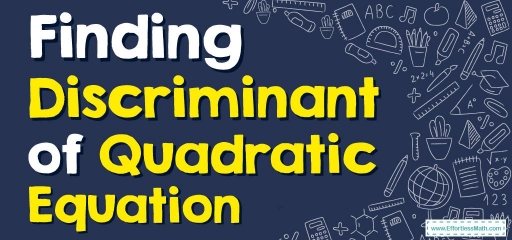How to Find Discriminant of Quadratic Equation?
The discriminant is part of the quadratic formula below the square root. Read this article to know how to find the discriminant of the quadratic equation.

The discriminant in mathematics is defined for polynomials and is a function of polynomial coefficients. Expresses the nature of the roots, or in other words, it discriminates against the roots.
Related Topics
A step-by-step guide to finding discriminant of quadratic equation
Discriminant of a polynomial in math is a function of the coefficients of the polynomial. This is useful in determining the type of solutions to a polynomial equation without actually finding them. That is, it distinguishes the solutions of the equation (equal and unequal; real and unreal) and hence it is called “discriminant”. The value of the discriminant can be any real number (i.e., either positive, negative, or \(0\)).
How to find discriminant?
To find the discriminant of a quadratic equation, we just need to compare the given equation with its standard form and determine the coefficients.
Discriminant of a quadratic equation
The discriminant of a quadratic equation \(ax^2+bx+c = 0\) is in terms of its coefficients \(a, b\), and \(c\). i.e.,
\(\color{blue}{Δ\:Or\:D = b^2− 4ac}\)
Do you remember using \(b^2 – 4ac\) before? Yes, it is a part of the quadratic formula: \(x=\frac{-b\pm \sqrt{b^2-4ac}}{2a}\). Here, the expression that is inside the square root of the quadratic formula is called the discriminant of the quadratic equation. The quadratic formula in terms of the discriminant is \(x=\frac{-b\pm \sqrt{D}}{2a}\).
Discriminant, and nature of the roots
The roots of a quadratic equation \(ax^2+bx+c = 0\) are the values of \(x\) that satisfy the equation. They can be found using the quadratic formula: \(x=\frac{-b\pm \sqrt{D}}{2a}\). Although we can not find the roots just by using discriminant, we can determine the nature of the roots as follows.
If the discriminant is positive:
If \(D>0\), the quadratic equation has two different real roots. This is because, when \(D>0\), the roots are given by \(x=\frac{-b\pm \sqrt{Positive\:number}}{2a}\), and the square root of a positive number always results in a real number. So when the discriminant of a quadratic equation is greater than \(0\), it has two roots that are distinct and real numbers.
If the discriminant is negative:
If \(D< 0\), the quadratic equation has two different complex roots. This is because when \(D< 0\), the roots are given by \(x=\frac{-b\pm \sqrt{Negative\:number}}{2a}\), and the square root of a negative number leads to an imaginary number always. Therefore when the discriminant of a quadratic equation is less than \(0\), it has two roots which are distinct and complex numbers (non-real).
If the discriminant is equal to zero:
If \(D = 0\), the quadratic equation has two equal real roots. In other words, when \(D=0\), the quadratic equation has only one real root. This is because, when \(D= 0\), the roots are given by \(x=\frac{-b\pm \sqrt{0}}{2a}\), and the square root of a \(0\) is \(0\). Then the equation turns into \(x= -\frac{b}{2a}\) which is only one number. So when the discriminant of a quadratic equation is zero, it has only one real root.
Finding Discriminant of Quadratic Equation – Example 1:
Find the discriminant of the following equation \(3x^2+10x−8\).
Solution:
The given quadratic equation is \(3x^2+10x−8\). Comparing this with \(ax^2+bx+c= 0\), we get \(a =3, b = 10\), and \(c =-8\).
The quadratic discriminant formula is:
\(D = b^2- 4ac\)
\(=(10)^2- 4(3)(-8)\)
\(=100 + 96\)
\(= 196\)
Exercises for Finding Discriminant of Quadratic Equation
Find the discriminant of the following equation.
- \(\color{blue}{3x^2+4x-8=0}\)
- \(\color{blue}{5x^2+3x+1=0}\)
- \(\color{blue}{6x^2-x-15=0}\)
- \(\color{blue}{4x^2+4x+1=0}\)

- \(\color{blue}{112}\)
- \(\color{blue}{-11}\)
- \(\color{blue}{361}\)
- \(\color{blue}{0}\)
Related to This Article
More math articles
- Algebra 2 Worksheets: FREE & Printable
- 10 Most Common 6th Grade IAR Math Questions
- Geometry Puzzle – Challenge 61
- 7th Grade Wisconsin Forward Math Worksheets: FREE & Printable
- Full-Length TASC Math Practice Test
- The Wonderful World of the Triangle Inequality Theorem
- How to Represent Systems of Linear Equations Using Matrices?
- 8th Grade Scantron Math Worksheets: FREE & Printable
- The Ultimate 6th Grade North Carolina EOG Math Course (+FREE Worksheets)
- FREE ParaPro Math Practice Test





























What people say about "How to Find Discriminant of Quadratic Equation? - Effortless Math: We Help Students Learn to LOVE Mathematics"?
No one replied yet.